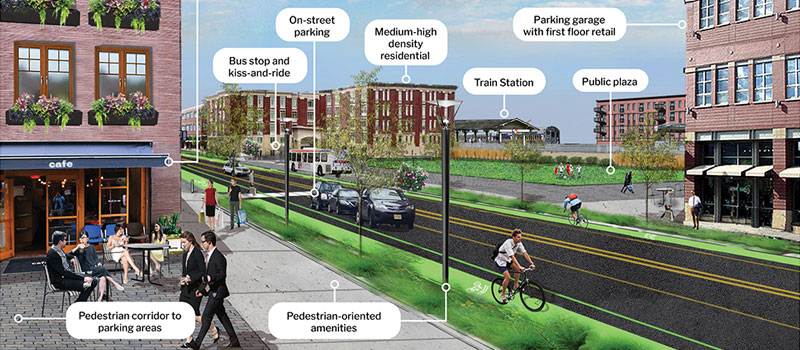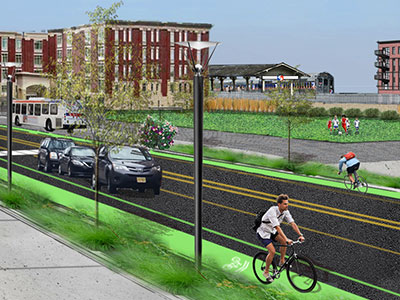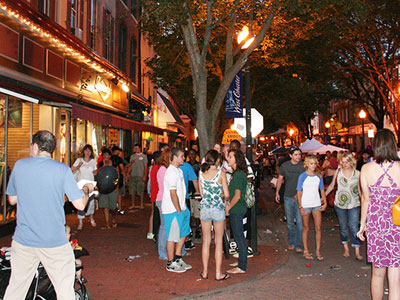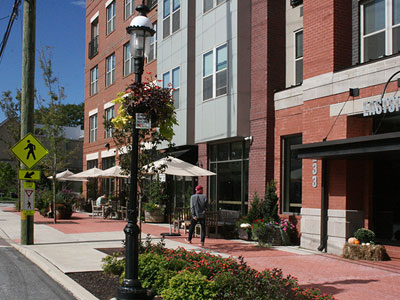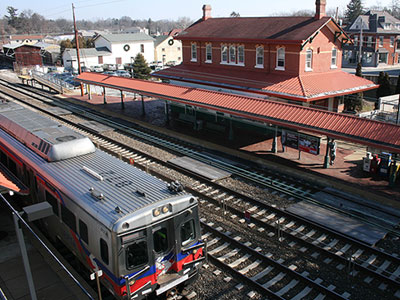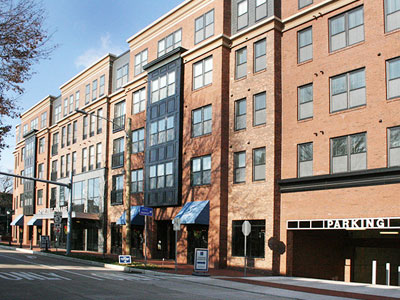Development near transportation hubs provides transportation choices while also creating a mixed-use, walkable sense of place.
Building Communities with Transit Oriented Development
The county's towns are classic examples of transit oriented development. West Chester, for example, has multiple bus routes and a transit center. New development in the downtown, when appropriately designed, is transit oriented development.
New TODs within half a mile of train stations, like this example in Malvern, can provide economic development and sustainability benefits.
How it Works
Successful TOD requires more than locating development near mass transit — TOD incorporates compact, village-like land use patterns at medium to high densities to encourage walking, biking, and using mass transit. Transit Oriented Development can be oriented around any form of mass transit including trains or buses. TODs include mixed-use elements and usually have residential, commercial, public spaces, multi-modal infrastructure, and mass transit components.
Benefits
Sustainability
TOD reduces greenhouse gas emissions by reducing vehicle miles traveled, and can preserve open space by diverting higher density development to infill sites.
Transit Diversity
TOD provides transit options for riders, increases transit use, and assists transit providers in planning for future service.
Economic Development
TOD stimulates economic activity, increases nearby property values, and adds foot traffic to local businesses.
Decreased Construction Cost
Parking construction can be a significant portion of construction costs. TOD limits the amount of parking needed, which can therefore decrease construction costs and add opportunities for affordably-priced housing.
Infrastructure
TOD can utilize existing infrastructure, reducing the need for costly new or extensions of facilities such as sewer, water and highways.
Community Character
TOD is reflective of early 20th century town patterns, which are characteristic of Chester County’s heritage.
Health and Safety
TOD promotes walking, encourages a sense of community, and increases safety by extending hours of activity through generating additional uses near transit facilities.
Aging Population Support
TOD provides housing options for seniors close to amenities and mass transit.
Chester County's twelve train stations, with 10 served by SEPTA and 5 by Amtrak, are great locations for transit oriented development, particularly existing commercial and mixed use areas near these stations.
Get Started
Developing a clear and coordinated planning approach can be imperative to successful TOD development. Municipalities should create clear visions for TODs and include them in planning documents including comprehensive, transportation, and revitalization plans. Municipalities may need to amend zoning and subdivision and land development ordinances to support TOD. TOD should be offered as a "by-right" land use in designated areas near transit facilities, with specific standards to allow for mixed land uses and higher densities.
Creating TOD zoning districts or overlays can be used to ensure that higher density development occurs primarily around transportation nodes. When drawing district boundaries, municipalities should include all parcels that can reasonably be expected to generate additional pedestrian trips to transit nodes. This can include parcels within a half mile of the transit node that have either current or potential sidewalk connections to the node.
Different types of transportation will require different types of zoning implementation. In Chester County bus stops, SEPTA and Amtrak stations, and bus terminals are all different types of transportation nodes that can become TOD districts. Municipalities with multiple transportation node types should consider creating unique TOD zoning districts for each type.
Allowing for higher densities alone will not create TODs, as TODs are more than housing near transportation options. Zoning will need to include form and design considerations to promote actual TODs by making it safe, easy, and appealing to walk to transit stations. In addition to higher densities, zoning should promote public spaces, connected street patterns, sidewalk connections, maximum setbacks, street facing entrances, and minimum building heights.
Funding may be available to assist with TOD development. Municipalities can consider potential funding sources such as the Transit Revitalization Investment Act (TRID) funding, Tax Increment Financing (TIF), tax revenue through a Business Improvement District (BID), DVRPC's Transportation Community Development Initiative (TDCI), or Local Economic Revitalization Tax Assistance (LERTA). Municipalities can pair these funding sources with Transferable Development Rights programs to direct growth away from rural areas to urban and suburban center growth areas that have transit facilities.
Development near bus stops can also be transit-oriented, particularly for frequently-used buses. This apartment building in West Chester has a bus stop in front of it.
Transit oriented development should meet the needs of transit users, bicyclists, and pedestrians, while also accommodating automobiles.
Considerations
Site Location
Plans should identify as TOD opportunity sites those areas with current transit infrastructure as well as job centers within or with access to the area. Transit infrastructure can include transit service, rail lines, bus lines, transfer centers, and major transit stops.
Community Character
TODs need to carefully reflect community character, providing transitions to nearby single-family neighborhoods while simultaneously creating community focal points that do not overwhelm the area.
Coordination
TOD may require collaboration between stakeholders including municipal officials, the public, transit agencies, and developers for successful implementation. Early engagement of stakeholders, designation of a project lead, and a clear vision and master plan are integral to the success of TOD.
Multi-Modal Planning
TODs are developed along public transit infrastructure, however, municipalities will still need to plan for pedestrian, bicycle, and automobile use. Covered parking garages with first floor retail, and "kiss-and-ride" drop off facilities can be used to accommodate automobile needs. Municipalities can plan for bicycles and walkers with wide sidewalks, street lighting, signage, transit shelters, bike lanes, traffic calming, seating, and trash receptacles and create pedestrian friendly spaces with public plazas, trees, landscaping, and public art.
Neighborhood Opposition
Concerns over density, traffic congestion, fiscal impact, and crime may cause pushback from adjacent residents. Municipalities should consider appropriate regulations and work with community members to determine how to best provide for a range of housing options for residents. Municipalities should also work to address neighborhood opposition by discussing TOD impacts and benefits including:
- TOD can cause less new automobile traffic than lower density housing types due to residents choosing alternative modes of transportation easily accessed in TOD.
- On average, higher density homes with two or fewer bedrooms add fewer new school-aged children per unit than detached single-family homes.
- Increased apartment growth often has a net fiscal impact, even higher than non-residential uses.
- New housing provides increased tax revenue and construction jobs.
- New residents support existing businesses and attract new business growth.
- Compact development limits greenfield development.
- A diversity of home types — apartments, cottages, twins, townhouses, and stacked townhouses — can add to the character of an area and create special places, as many of the county's boroughs exemplify.
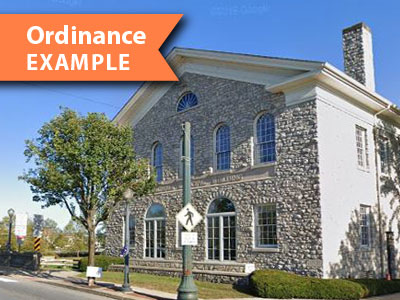
Examples
Downingtown created the Traditional Neighborhood Development District zoning overlay to encourage mixed-use moderate-density transit-oriented development along the R-5 commuter line. The zoning encourages mixed-uses, open space, a traditional grid street pattern, multi-modal connections, reuse and preservation of abandoned industrial buildings, and residential development at varying scales appropriate to the existing neighborhoods.
The new zoning enabled the proposed new train station and TOD to the east of the existing station. Downingtown, PennDOT, and the Hankin Group began implementation of the development. The proposed project will include 442 residential units, 14,200 square feet of commercial space, and a new train station. The extension of two public trails and construction of a new pedestrian bridg across the Bradywine Creek will help to create multi-modal connections to the station. Downingtown approved a conditional use permit for the project.
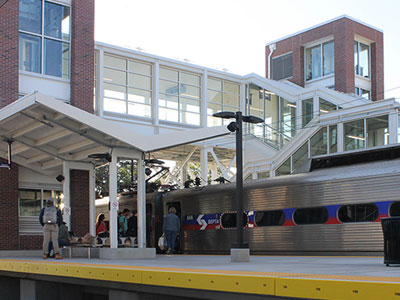
The Paoli Train Station can serve new transit oriented development in both Tredyffrin and Willistown Townships. This station is an example of how municipal officials, transportation agencies and local stakeholders are working together to achive a common redevelopment goal of the train station and its surrounding area. The area includes the newly developed Airdrie apartments.
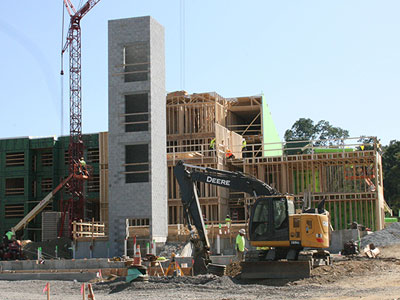
East Whiteland Township has started to see new development along Route 30 that is more transit oriented than the existing development. The East Whiteland Route 30 Corridor Master Plan, 2018 is an example of planning for TOD for potential transportation opportunities.The plan includes goals and implementation strategies that encourage TOD, such as creating bicycle and pedestian connections, enhancing local identity, creating mixed use centers, generating diverse housing opportunities, and advocating for a new train station.
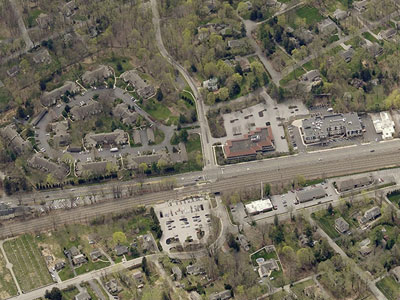
In Daylesford, office workers and staff at a live care facility can walk to the train station. The area around the Daylesford SEPTA station has seen higher density developments that are compatible with the station including the Dayelsford Crossing Assisted Living community, and Bryn Mawr Trust offices.
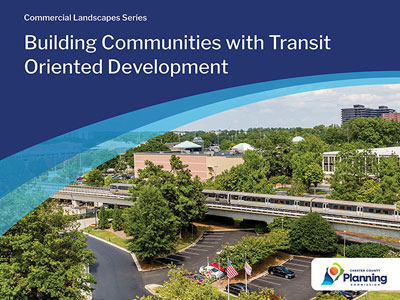
The Chester County Planning Commission has created a detailed guide to transit oriented development, titled Building Communities with Transit Oriented Development, as part of its Commercial Landscapes series.
Willistown Transportation District
In Willistown Township, the "TD" Transportation District is an example of a TOD that is located in the Paoli area and designed to encourage mixed-use, walkable redevelopment.
Coatesville Strategic Plan
The Coatesville Strategic Plan includes strategic actions to promote TOD around the rebuilt Amtrak station. Strategic steps include establishing a TOD overlay district, coordinating bus service to the station, and conducting a feasibility study for the return of SEPTA service.
Addison Circle, Addison, TX
A highlighted project by the Transit Oriented Development Institute, Addison Circle is an example of a suburban TOD project. After seeing extensive commercial growth in the 1990s, the Town of Addison, a first-ring suburb of Dallas, desired to create a sense of place for the community. The town identified and created a TOD on an 80-acre site centered around a train station. The TOD includes high-density mixed uses with pedestrian-friendly infrasturcture, and public parks.


